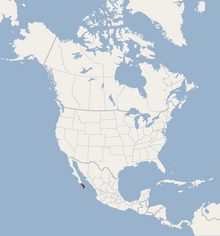Baja California mouse-eared
| Baja California mouse-eared | ||||||||||||
|---|---|---|---|---|---|---|---|---|---|---|---|---|
| Systematics | ||||||||||||
|
||||||||||||
| Scientific name | ||||||||||||
| Myotis peninsularis | ||||||||||||
| Miller , 1898 |
The Lower Californian mouse- eared bat ( Myotis peninsularis ) is a species of bat from the smooth-nosed family (Vespertilionidae), which is native to Mexico . The species is considered endangered. The species is so named because it can only be found on the peninsula (Latin: "peninsula") Baja California .
description
The Niederkalifornische mouse ear heard with a head-body length mm 44.8 to 55.0 and a forearm length from 37.2 to 40.6 mm from one of the largest mouse-eared bats in North America. It looks similar to Myotis velifer , but is smaller than it. The fur is clay-colored, with the base of the individual hairs being yellowish gray. The peritoneum is lighter. Males are usually described as more yellowish than females. Females are also slightly larger than males ( sexual dimorphism ). M. peninsularis differs from Myotis evotis , which also occurs on the peninsula , in its shorter ears, and from Myotis californicus , Myotis ciliolabrum and Myotis yumanensis in its larger body size and an uncompromised calcar . Myotis vivesi , on the other hand, is much larger than the peninsularis muscle .
Way of life
Very little is known about the way of life of the Lower Californian mouse-eared mouse, especially since the population is relatively small and the range is very limited. The species was found in just five caves. Mating takes place before hibernation , with the females storing the sperm and the egg not being fertilized until spring. Between June and July, the females give birth to a single young. During and after birth, the females form mother colonies of up to 5,000 animals in caves, which gather until the young are independent.
distribution and habitat
The Niederkalifornische mouse ear comes in a just 5,000 square kilometer area in the south of Lower California peninsula (Baja California) in Mexico before. The population is classified by the IUCN as endangered because of its small distribution area.
literature
- ST Alvarez-Castaneda & MA Bogan (1979) Myotis peninsularis . In: Mammalian Species , No. 573, pp. 1-2
